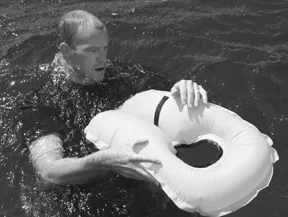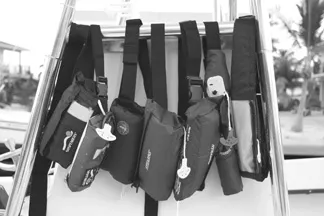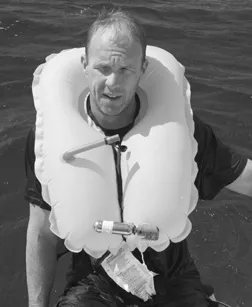
Belt-style inflatable lifejackets are no doubt the most comfortable personal flotation devices (PFDs) on the market. They weigh only a few pounds, and as their name indicates, you simply strap them around your waist like a fanny pack.
The rolled-up package that holds the belt’s inflatable chamber(s) is intended to sit just below your belly button, protruding only a few inches. The belt-pack inflatables also can be had for under $60, which is roughly a third of the cost of some vests. But—and this is a big but—some of these comfortable and cheap belts have limited buoyancy ratings, which makes a significant difference if you’ve fallen overboard and are struggling to find your next breath.
The buoyancy ratings of the seven belts we tested vary from 15.5 to 35 lbs. Further differences between vest-style and belt-style inflatables exist in the areas of comfort, fit, and warranty.
One caveat: Because someone who is injured while falling overbard may not be able to don a belt-style inflatable PFD, we don’t feel these devices are preferrable to those worn as vests.
Background
When activated, these belts give birth to a conventional lifejacket. Most belt-style PFDs contain a full-sized vest, packed into a small pouch carried on a waistband. The vest simultaneously pops out of the pouch and inflates. The user must then put the vest over his head and adjust the various straps.
Both styles, once approved by the Coast Guard, are classified as Type V special purpose devices and given performance classifications of either Type I, II, or III. At this time, no inflatables have been approved with Type I performance. For reasons known only to the U.S. Coast Guard regulatory hierarchy, automatically deployed, inflatable, vest-style PFDs can display and advertise Type II performance while manual-only vests are limited to Type III.
All belt-style inflatable PFDs are limited to Type III even if they meet the automatic deployment and buoyancy requirements of the higher rating. Why? Because the user has to put on the inflated device after it’s inflated.
To achieve their various performance ratings, all the belts we tested must be worn while underway. Manually deployed inflatable belts with a Type III performance rating must provide 22 to 24 lbs. of buoyancy to be used offshore. Two of the belts we tested are restricted to inland waters only because they provide less buoyancy. All Type V inflatables must also carry an oral-inflation tube for backup.
What We Tested
Four makers provided us with products. Mustang supplied a single unit, the MD3025, Seapro sent its SSB25 belt, and Sospenders loaned us its 38MBP. All three are manually deployed. Stearns sent three units for testing: two manuals, the 340 and 375, as well as an auto/manual belt, the 575. A single belt from West Marine rounded out the field—West’s Manual Inflatable Belt Pack, model no. 3742103. (It is the same as the Sospenders 16MBP, and is manufactured by Sospenders.)
How They Work
The size and shape of the belt packs vary widely among the models we evaluated. The manual firing mechanisms used on all but one of the belts differ in detail, but operate on the same principle. The user pulls a cord connected to the mechanism that allows a pin to penetrate a CO2 cylinder and inflate a bladder. Manual inflators are held to a strict inflation standard that requires they reach design buoyancy within five seconds of activation.
Halkey-Roberts, the Florida firm that makes the manual inflators for Sospenders, Mustang, and Stearns, uses simple mechanical leverage to force a pin into the CO2 cartridge. Cartridges for this inflator are screwed into place. Once activated, this inflator requires replacement of a pin as well as a new CO2 cartridge to be returned to service. A newer version used on the Sospenders 38MBP uses a special cartridge with a plastic tip that requires only a push and a quarter-turn twist for installation. This inflator uses spring power to pierce the CO2 cartridge when activated.
Blue Fin, Inc. makes the Seapro inflator. It uses standard, threaded CO2 cartridges. Returning this inflator to service following activation is a simple matter of resetting the operating lever and screwing in a new cartridge. It is the easiest inflator to rearm of all those we tested.
Secumar-Stearns, a European-US venture, supplies the firing mechanism for the Stearns 575 belt. This inflator has automatic and manual deployment capabilities. It makes use of an aspirin-like cellulose-based pill that’s loaded in a lever-accessed compartment to hold spring tension in check. When water dissolves the pill, the spring pushes a pin into the CO2 cartridge and inflates the belt. To rearm, you must install a new pill and new CO2 cartridge. If the user manually inflates the belt, rearming requires the replacement of a pin.
How We Tested
A pair of editors did all our testing. Both testers donned every belt, jumped in the water with them on, and rearmed and repacked each belt.
Each PFD was rated for ease of donning—how easily did the buckles and waistband operate? Did they feel secure? Were they easy to adjust to the proper size? Did they slip? And once donned, the not-yet-inflated belts were rated for comfort and fit.
In-water testing was done at two locations. One tester donned and rated each vest by jumping into a protected body of water dressed in shorts, shirts, socks, and shoes from a height of about four feet. To confirm that adequate lift was provided from this category of PFD, our second tester jumped into offshore ocean waters with waves running 4 to 6 feet. We used a consensus from both the inshore and offshore tests to come up with the in-water comfort/fit rating shown in the chart on page 12.
The one automatic vest—the Stearns 575—began to inflate before the subject resurfaced during both in-water tests. Manual vests were activated once the tester had returned to the surface following the jump. All deployed as advertised.
The design of nearly all of the belts requires the user to slip an opening in the vest over his or her head and then tie off additional straps. With the PFD inflated while in the water, we rated each vest for how easy it was to complete the donning proceess and for comfort and fit. Then each tester attempted to swim both prone and then supine.

Testers also used the oral inflator tube and tried to adjust the straps and buckles in the water.
Additional testing included a spray test to determine if automatic deployment would occur in rain or sea spray. We hit our one automatic belt with a freshwater hose for a full two minutes with enough water flow to simulate heavy rain or sea spray, but it didn’t inflate.
To select an overall winner, we considered the ease of donning, comfort/fit on land, comfort/fit in water, ease of rearming/repacking, and buoyancy. Warranty details were also taken into account.
Mustang AirForce
When packed in its waist pouch, the MD3025 measures about 2 inches thick, 4 inches high, and 8 inches long. Both testers found the 1½-inch-wide waistband easy to adjust and rated it Good for donning.
During the inshore test, the Mustang popped out of its pouch on impact with the water. This made it hard for the tester to find the pull-tab used to activate the CO2 cartridge. Once he located it, the belt inflated properly.
The Mustang has a rectangular shaped bladder with a triangular opening near the top. Once fully inflated, the user must make sure the correct side is facing his body and then stick his head through the triangular hole and pull the bladder down around the neck. Lastly,he user must tie a pair of neck straps. The MD3025 is the only belt tested equipped with a whistle.
Our first tester found it difficult to pull the bladder over his head and once accomplished, found the fit around the neck to be tight and uncomfortable. Our second tester, who has a smaller head and thinner neck, found the Mustang easy to put on and quite comfortable in the water.
In offshore buoyancy testing, the Mustang was rated Excellent. It provided lots of buoyancy and was very stable in the water. And it did a better job than most of the other belts of blocking the spray and water from splashing the tester in the face.
One problem we noted on the Mustang was the inflator tube. The tube kinks when you pull it to your mouth, preventing air from flowing through it.
We found the Mustang AirForce MD3025 priced just under $76 with a rearming kit for about $19. It carries a 1-year warranty.
Bottom Line: A good belt with plenty of flotation. For some it can be uncomfortable to wear in the water and, in our view, the inflator tube needs to be reworked to function more reliably.
Seapro
Seapro’s SSB25 inflatable belt has a pouch measuring approximately 2½ inches in diameter with a length of 14 inches. Its inflator is exposed, making the green “ready for service” window easy to see. Our testers found the 1½-inch-wide waistband harder to adjust than the other belts. Once on, both thought it was somewhat stiff around the waist.
Inshore, the Seapro inflated properly, was easy to pull over the head, and very comfortable in the water. Its design leaves a large area for the user’s head to pass through. A single strap running down the middle of the vest, marked with a large orange tag, allows the vest to be pulled closer to the user’s waist if desired. The Seapro also has neck straps that require tying.
Offshore, we found it easy to complete the donning, but our tester reported that the inflated bladder pulled uncomfortably on his neck and ears. Another problem noted was the tangling of the center adjustment strap; our tester could not move it at all. It may have gotten twisted when we repacked it. This isn’t a big deal because the strap is only for fine-tuning the fit. The manufacturer said the fit around the neck and ears would improve if the strap was not tangled.
Buoyancy of the SSB25 was rated Good; it provides adequate lift but lacks the freeboard of the belts with larger CO2 capacity. We also noted waves acting on the vest caused substantial bladder movement; this did not instill confidence offshore.
At $139.95, the Seapro SSB25 is the highest priced belt, nearly double the median price of our group. Rearming cost is the lowest: $5. The manufacturer expects the price to drop below $100 next year. The unit carries a 1-year warranty.
Bottom Line: In the water, the Seapro is easy to don and comfortable to wear. However, it lacks the buoyancy of the best and is quite expensive.
Sospenders/West Marine
The Sospenders 38MBP inflatable bladder is about one third larger than its little brother, the 16MBP. It fits in a pouch that measures 3 by 4 inches with a length of 9 inches. The smaller 16MBP pouch is approximately 2 by 3½ by 9 inches. The larger capacity belt carries a 2-inch waistband while the smaller version relies on a 1-inch belt. Both testers found the pair easy to adjust.
In the water, the testers had some difficulty pulling the bladder over their heads and one found it an especially tight fit around the neck, with the inside edge of the bladder’s neckhole irritating his skin. The vest has a single center adjustment strap offering about 3 inches of travel, and a pair of neck straps to provide additional security. Overall, the belt was rated Fair for in-water comfort/fit. Buoyancy on the big Sospenders is rated Excellent. It has the most lift of any belt tested and provides plenty of freeboard to keep the user’s head clear of the water’s surface.
When fully inflated, the smaller 16MBP belt provides about 22 pounds of buoyancy. The caveat is the user must blow into the inflator tube to completely fill the bladder. The 16-gram CO2 cartridge only partially inflates the vest, and does not provide enough air to keep you afloat. Inshore, the tester could easily dive several feet under the water after the cartridge had fully discharged. The upside to this design is that the under-inflated bladder is very easy to slip over your head.
Offshore, this smaller PFD allowed waves to wash over the tester’s face. (Coast Guard certification of this vest is valid only for inland waters.) The Sospenders 16MBP’s in-water comfort/fit was rated Good, while buoyancy was rated Fair.
We found the 38MBP priced at just under $61, with the rearming kit selling for $12. It carries a 1-year warranty. At West Marine, the 16MBP (model no. 3742103) is priced at $69.99 in the catalog and $59.99 on the website. The rearming kit (model no. 3835642) is $14.99. West Marine products carry the “No Hassle Guarantee” that states: “If you are ever dissatisfied with your purchase, simply return it. We’ll repair or replace the item, issue a credit, or send you a refund.”
Bottom Line: Excellent buoyancy for the buck despite the rough neck, lifts the Sospenders 38MBP to the top of our test.
Stearns
Everything about the Stearns 375 and 575 is identical except for the inflation method. The 375 is manual only, while the 575 is auto/manual. Both deploy to full vests when inflated. When deflated, they fit in a pouch that measures 2½ by 5 by 10 inches long. The waistbands on both are 1½ inches wide and were easy to size properly. Both were rated Good for donning and comfort/fit on land. The other Stearns model tested was the 340; its pouch measures about 2½ inches in diameter and 24 inches long. Both testers found it easy to adjust and the most comfortable belt to wear.
Like the Mustang, our inshore tests determined both the 375 and 575 vests difficult to pull over the head. Once on, both PFDs were tight and somewhat uncomfortable. In our offshore tests, both were much easier to don in the water and quite comfortable to wear.
Buoyancy was rated Excellent on both units because they provide substantial freeboard. They each have a pair of adjustment straps, with about 4 inches of travel. The straps are set a couple inches off the centerline of the vest and connected to the waistband, allowing the user to adjust the fit. The 375 and 575 were the only models with reflective tape.
Stearns’ 340 model is the only belt we tested that did not inflate into a full vest. This unit’s bladder inflates into a large tube that rests on the wearer’s belly. A strap goes around the back of the neck to help hold the bladder in place and allow the user to reach the oral inflation tube. Like the smaller Sospenders unit, this belt carries Coast Guard certification only for inland waters. Testers found they had to remain vertical in the water to maximize the buoyancy of the Stearns 340 and even then they found it lacking.
We found the Stearns 375 priced at $70, the auto version 575 at $80, and the 340 at $60. Re-arming kits are $19, $20, and $8.25, respectively. Stearns offers no predetermined warranty period on its marine products, but states in writing: “Should a product with a manufacturing imperfection find its way to a dealer’s shelf, please write for written authorization to return the product for our evaluation. If found defective, we will repair, replace, or credit your account accordingly. We do not guarantee this or provide a written warranty, but extend our promise to fairly resolve all returns.”
Bottom Line: Though the Stearns 375 did well in all our tests, its higher price and unclear warranty policy leave it as our second place choice.

Conclusion
Belt-style flotation devices are generally less expensive and are more comfortable to wear than their vest-style brethren. But unlike the vests, belts require you to complete the donning process during an emergency situation. You must be able to yank the cord, pull the inflated bladder over your head, and then tighten and tie the strapping. With the (manual) vests, you just pull the cord. And, belt-style inflatables generally have less buoyancy than their vest counterparts. As we discovered during the offshore test, a few extra pounds of buoyancy can make a significant difference.
That’s why we’d opt for the Sospenders 38MBP, which delivers the most buoyancy for the dollar. Other belt-style inflatables are slightly easier to don in the water and some are certainly a bit more comfortable to wear, but the Sospenders performed best in real-world conditions, which were sloppy enough offshore to cause one of our testers to become seasick. The Sospenders belt is also comfortable to wear on land and easy to adjust.
In second place is the Stearns 375, which is several dollars more and has two pounds less buoyancy than the Sospenders unit, but performed better in the in-water comfort and rearming categories of our test.
Also With This Article
“Value Guide: Inflatable PFD Belts”
Contacts
• Mustang, 800/526-0532, www.mustangsurvival.com
• Seapro, 732/830-4802, www.seapromarine.com
• SOS Inc., 800/585-5876, www.sospenders.com
• Stearns, 800/333-1179, www.stearnsinc.com
• West Marine, 800/262-8464, www.westmarine.com



































